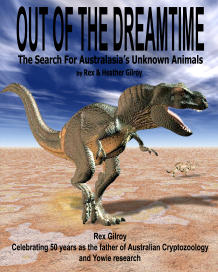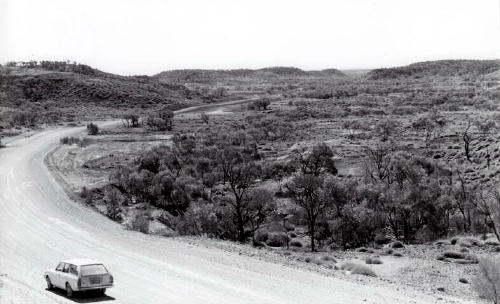
The arid, desolate ‘badlands’ landscape to be seen on the way to Lark Quarry, Winton in western Queensland. The region is rich in dinosaur fossil remains. Photo copyright © Rex Gilroy 2006.
Read Excerpts From
Out Of The Dreamtime -
The Search for Australasia’s Unknown Animals
by Rex & Heather Gilroy
Copyright
© Rex Gilroy 2006
No part of this publication including all photographs and illustrations may be reproduced or transmitted in any form or by any means, electronic or mechanical, including photocopying, recording or any information storage and retrieval system now known or to be invented, without permission in writing from the publisher, except by a reviewer who wishes to quote brief passages in connection with a review, written for inclusion in a magazine, newspaper or broadcast.
Dedication
This book is affectionately dedicated to my loyal, supportive and dedicated wife, and Number One researcher and fieldworker, Heather. This book is also affectionately dedicated to my late father W.F. [Bill] Gilroy [1904-1996], whose tales of his native Scotland and the Loch Ness Monster, led me, from about the age of five [!] to my lifelong research of the natural sciences and the fields of Cryptozoology and relict hominology, which has resulted in this book.
PART ONE
SETTING THE SCENE
“IN THE BEGINNING”.
__________CHAPTER TWO
Dawn Life of the DreamtimeDuring a natural science field investigation to South Australia in April 1988, Heather and I carried out a search in the Flinders Ranges. Our principal objective in this region was to locate rock formations of the Precambrian period containing macrofossils. These ranges are regarded by scientists as containing evidence of the earliest life forms to evolve on Earth.
We already had Precambrian macrofossils from Ediacara [South Australia], dated by a Macquarie University geologist at about 4,300 million years old, which places them among the oldest fossil life forms. Upon a hillside deep within the Flinders we found layer upon layer of slate rocks containing tiny organisms, clusters of segmented flatworms, and among other tiny lifeforms, jellyfish the size of a thumbnail and smaller!
There were ancient beach fronts of a primordial ocean, where fossilised sand ripple impressions revealed tidal flats dating back to the dawn of Dreamtime evolution. We uncovered slabs of slate rock with organisms so tiny that only the strongest jeweller’s eyepiece or microscope could detect. Later, upon inspecting the Precambrian rock stratas of Port Germaine Gorge, we discovered further extensive traces of tidal flat sand ripples, as well as tiny jellyfish and other minute organisms, later dated to the period 4,300 million years.
These earliest “unknown animals” evolved right here in Australia, truly the home of the most unusual creatures on this planet! The most up-to-date scientific evidence shows us that the creation of life on Earth began in the early Archaeozoic era of Precambrian times over 4,300 million years ago, in the warm seas which at that time covered a great part of the Earth’s surface.
Based upon fossil evidence of micro-organisms recovered from sites in Western Australia and South Australia, it would appear the earliest fossil remains of these organisms occur in what is now Australia, from where they spread out across the Earth. This first life was in the form of single cell organisms of microscopic size. Composed of chemical substances which they absorbed directly from the water, each cell enlarged itself before splitting in two.
Each of these identical cells subsequently split again and again; simple organisms that were the basic units from which all life forms would in the course of time evolve - bacteria, plants, insects and spiders, fish, reptiles, birds, mammals and man, everything. Through time, sheer chance and changing environmental conditions would direct the modifications that ultimately produced today’s world of living creatures. Yet while Life was evolving so were the continental landmasses.
The oldest rocks making up the Earth’s surface are called Archaeozoic and are metamorphosed, and lie beneath the Precambrian non-metamorphic rocks. While Archaeozoic era rock formations are also known from Swaziland, South Africa dating up to 3,000 million years old, the oldest Archaeozoic formations are to be found in Western Australia. These formations occur in an area extending from the Ashburton River in the north, and from the Nullarbor Plain in the east to the coastal plains in the west, all dating back well over 4,300 million years.
Geological evidence suggests that all of today’s landmasses were joined into a single continent, Pangaea, and although scientific opinion varies on the time scales involved, it is certain that this great single continent existed during the Palaeozoic era, around 600 to 270 million years ago. Then about 200 million years ago, early in the Mesozoic era, due to readjustment of the Lithospheric plates, the main landmasses of today began to break apart. This was the era when dinosaurs ruled the Earth. The Australian landmass at this time was itself part of a much larger super continent, Gondwana, which included Antarctica, India, South America and Africa as well as other smaller crystal blocks.
This super continent was joined to another, Laurasia, which comprised the later landmasses of North America and Europe/Russia and China, the two super continents separating by the close of the Cretaceous period, around 66 million years ago. By the time the dinosaurs had vanished, at the close of the Cretaceous period, most of the Gondwana super continent had broken apart, to create a pattern of continents similar to those we know today, although these were in different positions to what they are now. Australia and Antarctica were the last continental landmasses to separate [New Zealand is thought to have split from Australia].
Once Australia became isolated, free of outside influences, our unique marsupial and other native animal fauna were able to evolve. It is not my intention to go into great detail on a full geological history of Australia and the evolution of our native animal life. Readers wishing to pursue these aspects further can consult any number of books on these subjects. I merely wish to set the stage as it were, briefly revealing the awesome natural events which shaped Australia and our near-island neighbours, and the evolutionary process which would create the unique, known and ‘unknown’ creatures with which this book is concerned.
By the dawn of the last great Ice-Age, the Pleistocene period, which began around 2 million years ago, following the close of the Pliocene period, and which was to last until about 10,000 years ago, a wide variety of unique species had evolved in Australia. In fact, the Pleistocene period supported a vast number of life forms worldwide. At this time much of the northern hemisphere. was glaciated, creating extremely harsh conditions which differed considerably to those experienced in the southern hemisphere, which included the Australian region.For, unlike the northern hemisphere, the Australian continent did not experience extensive glaciations, this being confined to the Victoria-New South Wales Alps, and also Tasmania, which like New Guinea, was at that time joined to the Australian mainland. A great land-bridge had formed, extending from mainland Asia through what is now island south-east Asia to New Guinea-Australia, and as will be demonstrated later in this book, an extension of this ‘bridge’ extended from New Guinea to New Zealand.
Apart from the southern alpine region, the rest of Australia experienced a warm and temperate climate. The interior was a land of richly vegetated plains, forests, lakes and river systems. This environment supported a vast population of marsupial, bird and reptile species, and they in turn provided an endless supply of food for our Stone-Age human inhabitants.
It was the age of the ‘megafauna’ - giant kangaroo species that ranged in heights of from 3 to 4 metres, shared the plains with more than one species of giant flightless bird. One of these, Dromornis stirtoni, reached 3 metres or more in height, weighing more than 500 kg. Roaming among them was the largest ‘mega-marsupial’ of all, Diprotodon optatum, nearly 3 metres long and 2 metres tall at the shoulder.
Crocodiles, today confined to the far northern Australian water courses, in those times ranged deep into South Australia, as stated earlier; and the ‘ancient giant butcher’, Megalania prisca, a giant 7 metres or more length, 700 kg weight goanna, preyed upon animal and human life large and small. Then, somewhere around 30,000 years ago, this idyllic Australian Ice-Age world began changing forever. The ‘megafauna’ and many other smaller species of animal and bird life began to disappear. Scientists have postulated two basic causes responsible for this devastating event; one is the climatic changes that overshadowed the close of the Ice-Age, and the other cause, it is claimed, was the hunting activities of Aboriginal man.
Yet, as I will argue later in this book, as evidence suggests there were earlier human inhabitants who were already present in Australia by the late Pliocene period, the extinction is more likely to have been a gradual process over a much longer period, accelerated only by the drying up of the continent. As the climate turned warmer, the southern ice-sheet retreated and the interior of Australia became a vast, parched wasteland and a monumental drought began that was to last for several thousand years.
With the melting of the ice-sheets worldwide, the sea levels began to rise, gradually separating Australia from New Guinea, and Tasmania from the mainland; while the remaining land-bridges were flooded to form the present-day island chains of south-east Asia and Melanesia-New Zealand. Our Aboriginal people preserve traditions, not only of these geological and environmental events, but also of the marsupial, reptile and bird ‘megafauna’ of those times.
Their myths and legends speak of other creatures that roamed this continent in the Dreamtime dawn of creation - man-like beings, many of whom were giants, and some of truly gargantuan height and proportions which we shall meet later on in this book.
In recent years palaeontologists have made some remarkable finds around Australia, which have extended the list of hitherto unknown marsupial, reptile and bird species of the Pliocene-Pleistocene periods considerably, meanwhile anthropologists who once doubted that Aboriginal occupation of Australia would ever exceed 40,000 years, or that Homo erectus and other pre-Aboriginal [Australoid] races of Man inhabited this continent, have had to change their views in the light of recent fossil Aboriginal remains dating back 65,000 years, and the growing realisation that Homo erectus may have been present here at an even more remote period.
The fossil skull-types, fossil footprints and other evidence to be presented later, in the section of this book dealing with the Yowie mystery and its origins, should leave little doubt in the reader’s mind, that there exists an ‘unknown’ Australian stone-age past which rivals that of Africa and Asia in the quest to find the true homeland of human origins. I believe Australia was that homeland!
Main Book Index | Mysterious Australia Homepage | URU Homepage | Australian Yowie Research Centre
